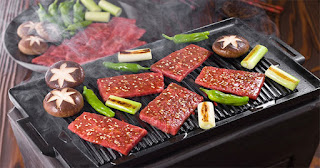 |
| yakiniku - www.healthnote25.com |
Yakiniku (焼
肉?,
Roasted meat) is a Japanese term for roasted or burned meat on a fire. In a
broad sense, my beliefs also include a variety of roast beef, pork or offal
dishes, such as steak, roast lamb (jingisukan), and barbecue.
Meat is roasted over the
fire from charcoal or gasses by using a grille of iron or on an iron plate
(teppan). The rectangular piece of meat is often punctured with a puncture of
metal before baking. At my convinced restaurant, after being roasted, a rather
large meat often needs to be cut with scissors in front of the visitors.
The term "horumon"
in "horumonyaki" is derived from the Kansai dialect
"horumon" (an object of exile) used to refer to the innards. The
confident difference with bulgogi or kalbi has become very blurred, as both are
also called "yakiniku" in Japan. Horumonyaki was created by Korean
immigrants in the Kansai region after World War II.
In the restaurant I'm sure,
the diners choose their own raw raw meat, one by one by type or a set of meat
in the dish. Restaurant diners are welcome to bake their own meat. The
meat-grinder is on the visitor's table, and can be a meat grill with a gas or
charcoal fire source.
Before being eaten, the meat
is dipped into a sauce called tare. Tare sauce has 2 types of niku tare (sauce
with seswijen) and soto tare (sauce not berwijen). Before baking, selected meat
and seafood are dipped in niku tare sauce, made from a mixture of ingredients
such as soy sauce, sake, sugar, garlic, and sesame. The rectangular piece of
meat is often pierced with a puncture of the metal before baking. Vegetables
such as bell peppers, onions sometimes also roasted with meat.








0 Comments:
Post a Comment